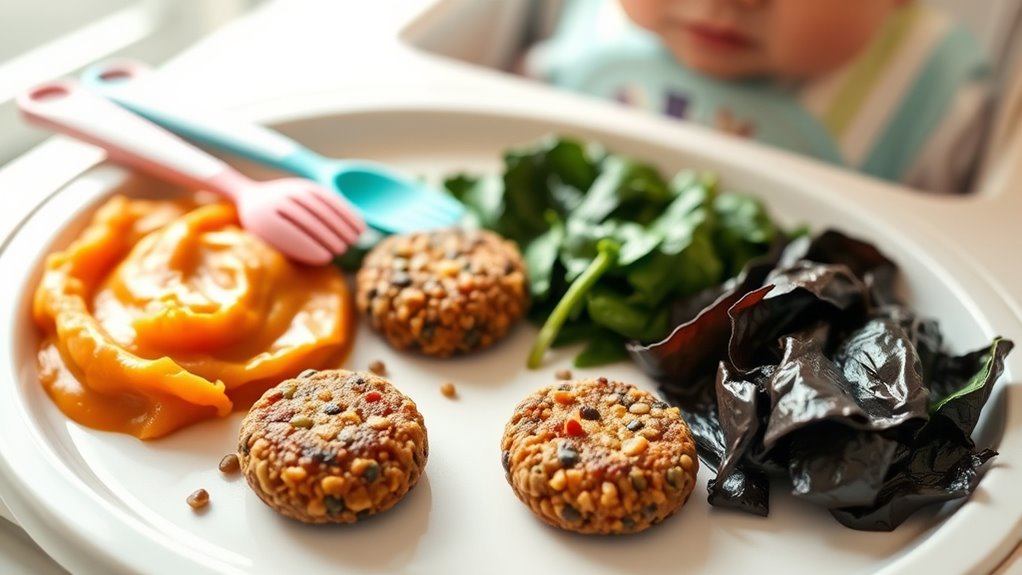To make certain your baby gets enough iron between 6 and 12 months, try offering iron-fortified cereals, pureed meats like chicken or beef, and soft-cooked egg yolks. Incorporate dark leafy greens such as spinach and kale, and pair them with vitamin C-rich fruits to boost absorption. Snacks like fortified puffs can also help. If you keep exploring options, you’ll discover more creative and safe ways to support your baby’s iron intake.
Key Takeaways
- Introduce iron-fortified cereals, grains, and leafy greens like spinach and kale to boost non-heme iron intake.
- Offer pureed meats such as chicken, turkey, and beef, which provide easily absorbed heme iron.
- Incorporate iron-rich legumes and lentils, paired with vitamin C-rich fruits to enhance iron absorption.
- Serve iron-fortified snacks and puffs, ensuring supervision and minimal added sugars for healthy development.
- Prepare foods thoroughly, adjusting textures from smooth purees to chunkier textures to promote oral motor skills.
Iron-Fortified Cereals and Grains

Iron-fortified cereals and grains are excellent first foods to help your baby get the iron they need between 6 and 12 months. These options are easy to prepare and digest, making them ideal for your little one’s developing digestive system. Iron fortified cereals, such as rice, oatmeal, and barley, are enriched specifically to boost iron intake, which is essential for healthy growth and brain development. You can serve these cereals plain or mix them with breastfeeding or formula to improve taste and texture. Additionally, exploring different grain options like wheat or multigrain options can introduce variety into your baby’s diet. Incorporating these nutrient-rich foods helps prevent iron deficiency and sets a solid foundation for healthy eating habits moving forward. Learning about gliding and soaring techniques can also teach patience and focus, skills beneficial for your child’s growth and development. Moreover, choosing age-appropriate foods ensures your baby’s safety while encouraging gradual acceptance of new flavors and textures. Including a variety of whole grains can further support your baby’s nutritional needs and promote a balanced diet.
Pureed Meat and Poultry Options
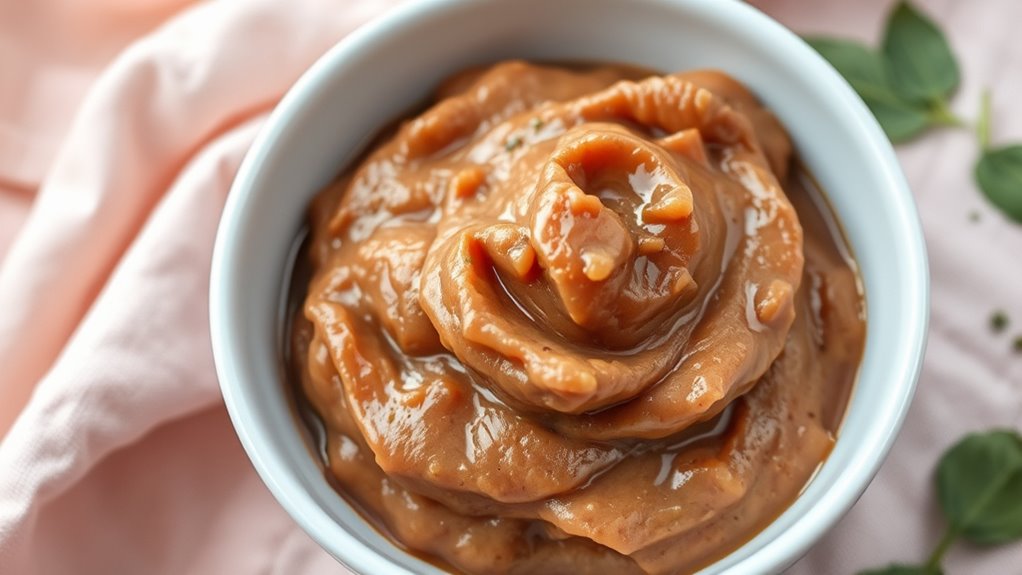
When choosing pureed meat and poultry, focus on options like chicken, turkey, and beef, which are rich in iron and easy to digest. Always prepare poultry safely by cooking it thoroughly and removing skin and bones before pureeing. For the best texture, aim for a smooth consistency and add liquids gradually to achieve the right thickness. Additionally, incorporating nutrient-rich ingredients can enhance the nutritional value of your baby’s meals.
Best Meats for Purée
Choosing the right meats for pureeing can help guarantee your baby gets the iron they need to support healthy growth. Opt for meats sourced from reputable providers to assure safety and quality. Chicken, turkey, and beef are excellent options because they’re rich in heme iron, which absorbs easily. Pay attention to meat flavor profiles; chicken offers a mild taste, making it ideal for sensitive palates, while beef provides a richer flavor that can help your baby develop taste preferences. Choose lean cuts to reduce fat intake, and always remove excess fat before pureeing. Incorporate these meats gradually into your baby’s diet to help build iron stores and promote healthy development. Proper sourcing and understanding meat flavor profiles guarantee you’re providing nutritious, safe foods for your little one.
Preparing Poultry Safely
To guarantee your baby’s safety and health, preparing poultry properly is essential before pureeing. Start by selecting fresh, high-quality poultry from a trusted source. Always cook it thoroughly to an internal temperature of 165°F (74°C) to kill harmful bacteria. Avoid cross-contamination by washing your hands, utensils, and surfaces after handling raw poultry. Once cooked, let it cool slightly before pureeing. Store leftovers in airtight containers in the refrigerator for up to 2 days, or freeze them for longer storage. Follow proper storage tips to prevent spoilage and ensure food safety. Never serve undercooked or improperly stored poultry to your baby. Proper preparation and storage are key to making safe, nutritious poultry options for your little one.
Texture and Consistency Tips
Getting the right texture and consistency for pureed meat and poultry is essential to help your baby swallow and digest easily. For texture development, start with smooth purees and gradually introduce thicker, chunkier textures as your baby becomes more comfortable. To achieve the ideal consistency, begin by blending cooked meat or poultry with a little water, breast milk, or formula until smooth. As your baby progresses, make consistent adjustments by adding small amounts of liquid to thin the puree or mashing for a slightly thicker texture. Keep in mind that different babies develop at their own pace, so observe your little one’s cues and adapt accordingly. Providing a variety of textures helps promote oral motor skills and encourages acceptance of new foods.
Incorporating Legumes and Lentils
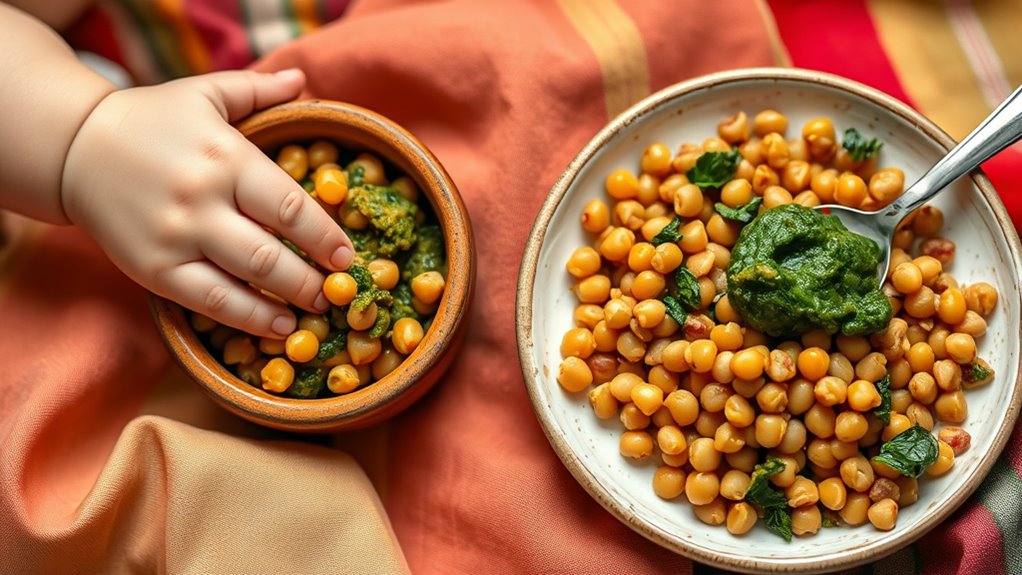
Adding legumes and lentils to your baby’s diet is a great way to boost iron intake naturally. These foods are rich in non-heme iron and versatile for meal planning. Start with different legume varieties like black beans, chickpeas, or kidney beans, and incorporate them into soft purees or small, manageable pieces. Lentil recipes are especially easy to prepare—try blending cooked lentils into smooth purees or mixing them with vegetables for added flavor. To guarantee safety and ease of eating, always cook lentils thoroughly and mash or chop them finely. Be mindful of potential allergens and introduce legumes gradually. Remember, combining legumes with vitamin C-rich foods enhances iron absorption, making every bite more nutritious.
Offering Soft-Cooked Egg Yolks
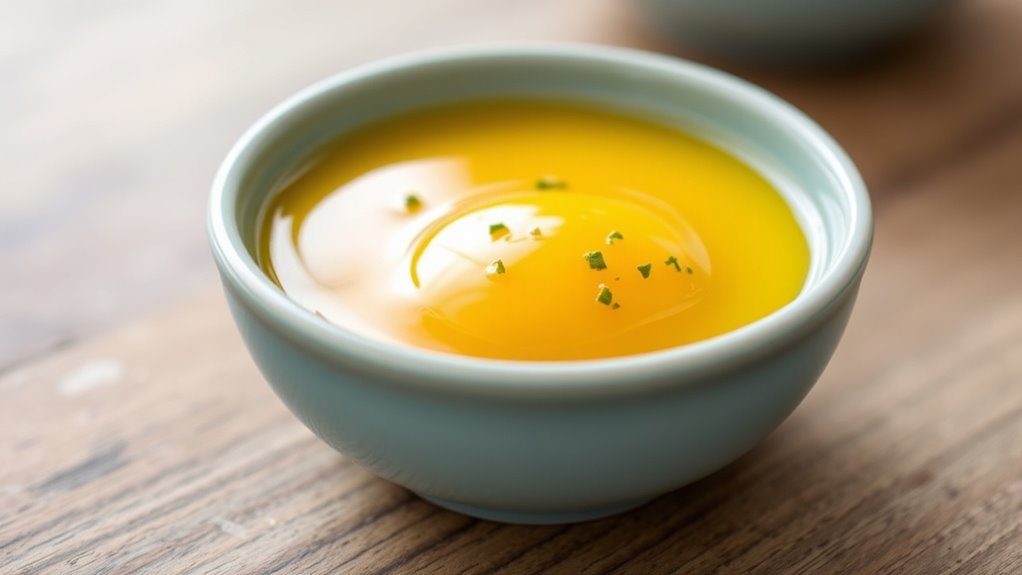
Offering soft-cooked egg yolks is another excellent way to introduce iron-rich foods into your baby’s diet. Egg yolk textures are naturally creamy and easy for your baby to swallow when cooked softly, making them suitable for early feeding stages. To prepare, gently cook the yolk until it’s just firm, avoiding runny textures to reduce choking risks. Be mindful of egg allergy considerations; introduce eggs gradually and watch for any reactions, especially if there’s a family history of allergies. Starting with small portions helps your baby adjust to new flavors and textures while ensuring they get essential iron. Incorporate soft-cooked egg yolks into purees or serve them mashed, offering a nutritious, iron-rich addition to your baby’s meals. Safe feeding practices are essential when introducing new textures to ensure your baby’s safety and comfort during meal times.
Introducing Dark Leafy Greens

Introducing dark leafy greens to your baby’s diet can boost iron and other crucial nutrients essential for growth. Make sure to prepare them safely by steaming and chopping finely to prevent choking. You can easily incorporate greens into meals by blending them into purees or mixing them with other first foods. Incorporating nutrient-rich foods like greens also supports overall health and development. Engaging in creative practice while preparing these foods can make meal times more enjoyable and help you discover new ways to include greens in your baby’s diet. Additionally, understanding relationships can encourage a nurturing environment that fosters your baby’s emotional well-being alongside their physical health.
Nutritional Benefits for Baby
Dark leafy greens like spinach, kale, and Swiss chard are packed with essential nutrients that support your baby’s growth and development. They provide a rich source of iron, which is indispensable for healthy blood and energy levels. Including greens in your baby’s diet helps improve iron absorption when combined with vitamin C-rich foods. Additionally, these greens contribute to dietary diversity, exposing your baby to different flavors and textures that promote healthy eating habits. Incorporating electric bikes as a sustainable transportation option can also inspire families to adopt eco-friendly habits. Some benefits include: – Boosting iron intake for healthy development – Supporting immune function with vitamins A and C – Promoting a balanced diet through nutritional diversity
Preparing Greens Safely
To guarantee your baby safely enjoys greens, it’s important to prepare them properly before serving. Leafy greens, like spinach or kale, can be nutritious but may contain natural toxins or dirt. To confirm preparation safety, wash the greens thoroughly under cold running water, removing any dirt or grit. Remove tough stems and chop them into small, manageable pieces suitable for your baby’s age. Cooking leafy greens by steaming or boiling helps break down oxalates and makes them easier to digest. Always avoid adding salt, sugar, or seasonings. After cooking, puree the greens until smooth, adding water or breast milk if needed for desired consistency. Proper preparation safety minimizes choking hazards and ensures your baby gains maximum nutritional benefits from leafy greens.
Incorporating Greens in Meals
Adding greens to your baby’s meals is an excellent way to boost their iron intake and support healthy development. Dark leafy greens like spinach, kale, and Swiss chard are nutritious options. To make them baby-friendly, use gentle cooking methods such as steaming or boiling to soften the greens and enhance digestibility. You can then puree or chop them finely for easy eating. Remember to remove any tough stems and rinse thoroughly to guarantee safety. Incorporating greens into meals can be simple—try mixing them into purees, adding them to porridges, or blending into smoothies. These methods preserve their nutrients while making greens palatable for your little one. Nutrient retention is important when preparing vegetables for infants to ensure maximum health benefits. Consistent exposure helps develop their taste preferences and promotes healthy iron intake. Recognizing these angel number signs can also encourage you to stay positive and patient during your child’s dietary journey. Additionally, understanding nutrient preservation techniques can help you maximize the health benefits of greens during preparation.
Serving Fortified Baby Snacks and Puffs

Fortified baby snacks and puffs are convenient options to help your little one get essential iron while on the go. These baby snack options are designed to be easy for your baby to hold and chew, making them perfect for busy days. When choosing snacks, check labels for added iron, ensuring they contribute to your child’s daily needs. To maximize iron absorption tips, serve these snacks alongside vitamin C-rich foods like fruit or vegetables, which can enhance iron uptake from fortified puffs. Always supervise your baby while eating to prevent choking. Incorporating fortified snacks into your child’s diet can be a simple way to boost iron intake without fuss. Just be mindful of portion sizes and choose options with minimal added sugars or artificial ingredients. Regularly reviewing your child’s feeding habits and ensuring a balanced diet supports overall nutritional quality.
Combining Fruits With Iron-Rich Components
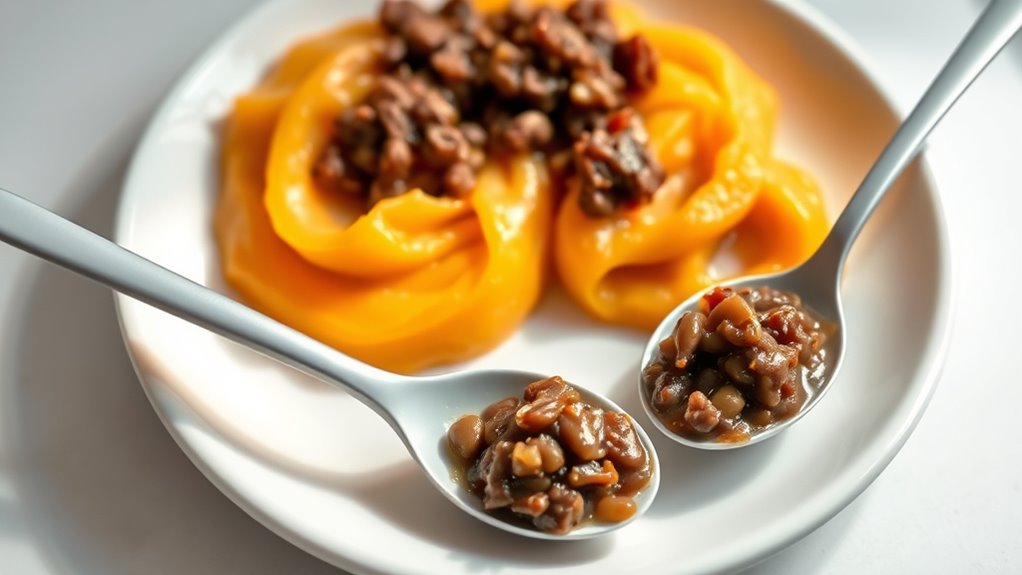
Combining fruits with iron-rich components is an effective way to enhance your baby’s iron absorption. Certain fruit combinations can boost iron uptake when paired with foods like pureed meats, beans, or fortified cereals. To maximize benefits, consider pairing vitamin C-rich fruits with iron sources, as vitamin C considerably improves iron absorption. You can try:
- Pureed strawberries or oranges mixed with pureed beef or chicken
- Mango or kiwi combined with lentil or bean purees
- Pineapple with fortified cereal or iron-fortified baby foods
In addition, using vacuums designed for delicate surfaces can help keep your kitchen clean without damaging your flooring or furniture. Incorporating nutrient absorption techniques into meal preparations can further support your baby’s health. These combinations make the meals more appealing and help your baby absorb more iron, supporting healthy growth and development. Incorporating vitamin C-rich fruits into your baby’s meals can make a significant difference in iron absorption. Remember, the key is balancing flavors while ensuring the iron sources are paired with vitamin C-rich fruits for ideal absorption.
Creative Ideas for Iron-Rich Purees
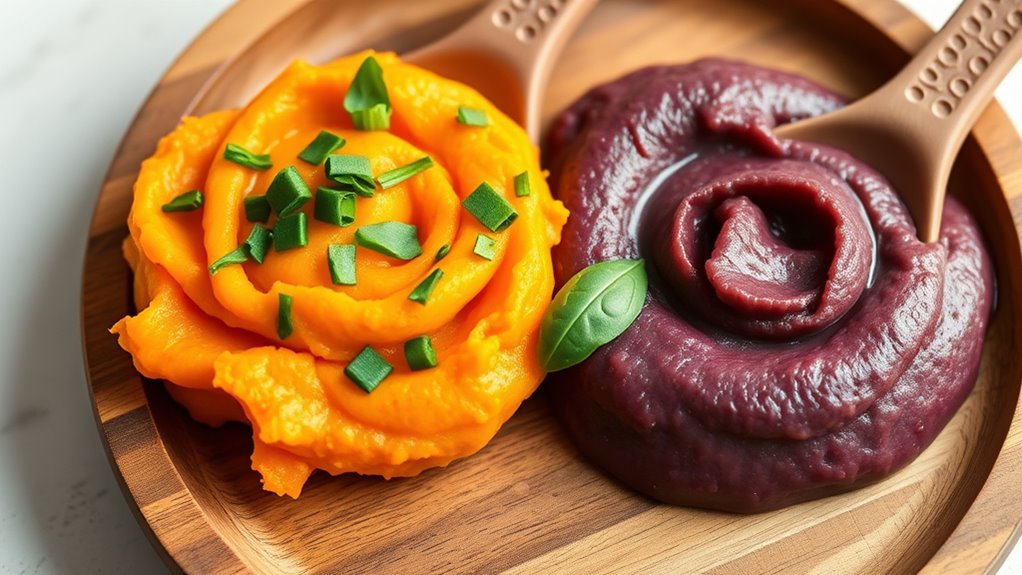
Creating appealing iron-rich purees for your baby can be both fun and nutritious. To keep mealtime exciting, experiment with creative flavor combinations like blending spinach with sweet potato or adding a touch of apple to lentil purees. These pairings introduce subtle new tastes while boosting iron intake. When it comes to visual presentation tips, aim for vibrant colors and layered textures—using contrasting hues like orange carrots against dark greens can make the puree visually stimulating. You might also try piping purees into fun shapes or creating small, colorful swirls on the plate. These simple touches not only make the purees more inviting but also encourage your little one to explore new foods with curiosity and joy.
Frequently Asked Questions
How Can I Tell if My Baby Is Getting Enough Iron?
You can tell if your baby is getting enough iron by watching for signs of iron deficiency, like tiredness or pale skin. Regular blood tests ordered by your pediatrician help confirm iron levels and make certain your baby isn’t deficient. If you’re concerned, discuss these tests with your doctor and include iron-rich foods in their diet, such as pureed meats or fortified cereals, to support healthy iron intake.
Are There Any Foods to Avoid When Introducing Iron-Rich Solids?
Did you know that about 8% of children under 18 have food allergies? When introducing iron-rich solids, avoid foods that commonly trigger allergies, like nuts or eggs, especially if your baby hasn’t tried them before. Also, steer clear of pesticides by choosing organic options when possible. These precautions help prevent allergic reactions and reduce pesticide intake, ensuring your baby’s first iron-rich foods are safe and healthy.
How Can I Improve Iron Absorption From Plant-Based Foods?
To improve iron absorption from plant-based iron sources, you should include vitamin C-rich foods like citrus, tomatoes, or peppers in your child’s meals. Avoid giving tea or dairy at the same time, as they can hinder absorption. Cooking in cast iron pots also helps. By combining plant-based iron sources with vitamin C and avoiding inhibitors, you enhance iron absorption effectively.
Can Iron-Rich Foods Cause Constipation in Babies?
Yes, iron-rich foods can cause constipation in babies, especially if they consume too much iron or if their diet lacks fiber. Iron supplements or iron overdose may worsen constipation. To prevent this, offer iron-rich foods alongside fiber-rich options like fruits and vegetables, and avoid giving excessive supplements unless advised by a doctor. Always monitor your baby’s response and consult your pediatrician to ensure proper iron intake and digestion.
How Often Should I Offer Iron-Rich Foods to My Infant?
You should offer iron-rich foods to your infant daily, fitting into their regular feeding schedule. Incorporate these foods consistently to support healthy iron levels. If your baby isn’t getting enough from food, your healthcare provider might recommend an iron supplement, usually given at specific times. Always follow their guidance on supplement timing and frequency. This routine helps guarantee your little one gets the iron they need for growth and development.
Conclusion
Feeding your little one iron-rich foods from 6 to 12 months is essential for healthy growth and development. Did you know that iron deficiency affects about 10% of infants worldwide? By including a variety of cereals, meats, greens, and fortified snacks, you’re setting your baby up for strong muscles and healthy brains. Keep experimenting with flavors and textures—your baby’s iron intake will thank you for it!
